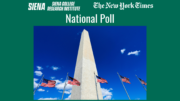Faso (Republican) & Teachout (Democrat) Hold Large Double Digit Leads in their Respective Primaries
Environment & Health Care Top Issues for Democratic Primary Voters; National Defense, Jobs, Deficit Top Issues for Republicans
Republicans & Democrats Have Opposite Views on Obama, Clinton, Trump, Others; Both Sides Strongly View Chris Gibson Favorably
Loudonville, NY. With three weeks until Republicans and Democrats go to the polls to select their candidates for the 19th Congressional District seat being vacated by Rep. Chris Gibson (R), John Faso has a 22-point lead over Andrew Heaney, 50-28 percent, in the Republican primary and Zephyr Teachout has a 30-point lead over Will Yandik, 53-23 percent, in the Democratic primary, according to new Time Warner Cable News/Siena College polls of likely 19th C.D. primary voters released today.
Among likely Republican voters, Faso has a 47-30 percent favorability rating, compared to Heaney’s negative 29-45 percent favorability rating; both are unknown to about one-quarter of Republicans. Among likely Democratic voters, Teachout has a 64-10 percent favorability rating, compared to 38-9 percent for Yandik. While Teachout is unknown to about one-quarter of Democrats, Yandik is unknown to more than half.
President Obama, Hillary Clinton and Bernie Sanders are all viewed overwhelmingly favorably by Democrats and overwhelmingly unfavorably by Republicans. Donald Trump is viewed strongly favorably by Republicans and overwhelmingly unfavorably by Democrats. Gibson is viewed overwhelmingly favorably by Republicans and strongly favorably by Democrats.
“With three weeks until primary day, Zephyr Teachout has the support of more than half of likely Democratic primary voters and a commanding 30-point lead,” said Siena College pollster Steven Greenberg. “In Ulster and Dutchess Counties, which is expected to account for nearly half of the votes in this Democratic primary, Teachout leads Yandik by more than 40 points, while holding double digit leads in the remainder of the district. While moderate Democrats, who comprise less than one-third of the electorate, provide Teachout with only a 13-point lead, among liberal Democrats, she leads by more than 40 points.”
“Teachout is more known to Democratic primary voters than Yandik and she is viewed favorably by nearly two-thirds, compared to the 38 percent who view Yandik favorably,” Greenberg said. “Interestingly, nearly half of voters say they’ve heard from Teachout’s campaign and nearly half say they’ve heard from Yandik’s campaign. And between one-quarter and one-third of the electorate claims to have seen or heard advertising for each of the candidates.
“On the Republican side, John Faso leads Andrew Heaney by 22 points, built from a 14-point lead among moderate Republicans – about one-third of the electorate – and a 25-point lead among conservatives, who comprise about two-thirds of the electorate,” Greenberg said. “While the race is very tight in Ulster & Dutchess Counties, which will produce about one-third of the voters, Faso enjoys a 19-point lead in the more southern portion of the district and a commanding 41-point lead in the five northern counties of the district.
“While Faso has a mildly positive 47-30 percent favorability rating among Republican primary voters, they view Heaney unfavorably by a 45-29 percent margin,” Greenberg said. “Heaney’s job in winning the primary is considerably harder when he’s viewed unfavorably by a 16-point margin and Faso is viewed favorably by a 17-point margin. Additionally, while both Faso and Heaney commercials have each been seen or heard by two-thirds of the electorate, and slightly more voters say they’ve been contacted by the Heaney campaign, primary voters say Heaney is running the more negative campaign by a 36-20 percent margin.”
Republicans & Democrats Have Different Priorities for the Next Member of Congress
The most important issue Republican primary voters want their next Representative working on is a toss-up among jobs, national defense and the Federal budget deficit, followed closely by protecting the Second Amendment,” Greenberg said. “Democratic primary voters say it’s environment and health care, with education and corruption in government fairly far behind the top two.”
“Democratic primary voters are traditionally far more liberal than the electorate in the general election, or even all registered Democrats, so it’s not a great surprise immigration, the Federal budget deficit and national defense drop to the bottom of the pack for these voters,” Greenberg said. “Likewise, Republican primary voters tend to be far more conservative than the general electorate or even all registered Republicans. Again, it’s not a huge surprise to see health care, immigration and education drop to the bottom of their priority list.”
Democrats Love Obama, Clinton, Sanders; Republicans are Trump Fans; Both Sides Agree on Gibson
“Obama is viewed favorably by 87 percent of likely Democratic primary voters and unfavorably by 84 percent of likely Republican primary voters. Those same Democrats give Clinton a 76 percent favorability rating and Sanders 72 percent, while those Republicans give Clinton an 88 percent unfavorability rating and Sanders a 71 percent unfavorability rating,” Greenberg said. “Flip sides, and Republicans give Trump a 65 percent favorability rating, while 92 percent of Democrats view him unfavorably.
“There is one person, however, who garners strong support from the liberal Democratic primary electorate and even stronger support from the conservative Republican primary electorate. And that’s retiring Republican Representative Chris Gibson, viewed favorably by 86 percent of Republican primary voters and 60 percent of Democratic primary voters,” Greenberg said. “In a sprawling, diverse district, Congressman Gibson has been able to earn and keep the trust and respect of voters across the partisan spectrum, an uncommon trait in today’s world where politics looks an awful lot like a combat sport.
“Three weeks in rough and tumble political campaigns is a lifetime and so primary voters in the 19th C.D. are likely to have their mailboxes, viewed websites, TV screens and radio stations filled with campaign advertising supporting and opposing various candidates over the next 21 days,” Greenberg said. “Teachout and Faso have large leads heading into the closing weeks of the campaign so the questions are simple.
“Will the front runners be able to hold the momentum or will they let it slip away? And which campaign on each side of the aisle will do a better job identifying their supporters and getting them to the polls? The questions are easy but the answers are still unknown. Time Warner Cable News and Siena will continue to monitor the campaigns to report on the answers to those questions as we get closer to June 28.”
# # #
These Time Warner Cable News/Siena College 19th C.D. primary surveys were conducted May 31 – June 2, 2016 by telephone calls to 436 likely Republican primary voters and 431 likely Democratic primary voters. The results have a margin of error of +/- 4.8 percentage points for the Republican primary poll and +/-4.7 percentage points for the Democratic primary poll, including the design effects resulting from weighting. Sampling was conducted via a stratified dual frame sample of historically active registered voters reached via landline and cell phone telephone numbers drawn from a sample provided by L-2 Voter Mapping. A likely voter screen was applied to initial respondents from this dual frame sample that was statistically adjusted to reflect gender and age in each case. The Siena College Research Institute, directed by Donald Levy, Ph.D., conducts political, economic, social and cultural research primarily in NYS. SRI, an independent, non-partisan research institute, subscribes to the American Association of Public Opinion Research Code of Professional Ethics and Practices. For more information, please call Steven Greenberg at 518-469-9858. Survey cross-tabulations and frequencies can be found at: www.Siena.edu/SRI/SNY.





